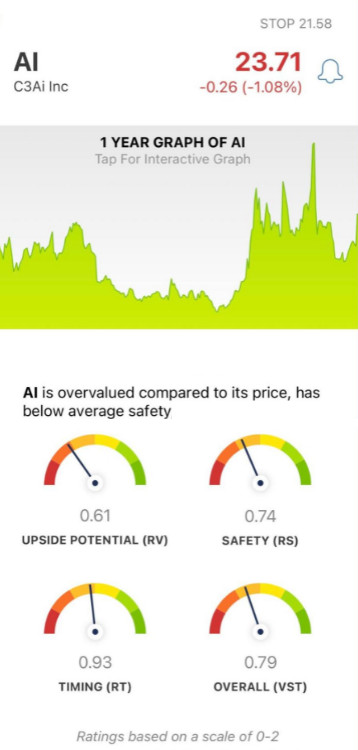20 Pro Facts For Choosing Using Ai To Trade Stocks Websites
20 Pro Facts For Choosing Using Ai To Trade Stocks Websites
Blog Article
Top 10 Tips To Determine The Quality Of The Data And Its Sources For Ai-Powered Stock Analysis And Forecasting Trading Platforms
In order to provide accurate and reliable data It is crucial to examine the data and sources that are used by AI stock prediction and trading platforms. A poor quality of data could result in inaccurate predictions and financial losses. It can also cause mistrust for the platform. Here are 10 top tips for evaluating sources and the quality of the data:
1. Verify the data sources
Check the source of the data. Verify that the platform uses well-known and reputable sources of data, such as Bloomberg, Reuters or Morningstar.
Transparency: The platform should be transparent about its data sources and should regularly update them.
Avoid single-source dependencies: Reliable platform often aggregate data across multiple sources to minimize the chance of errors and bias.
2. Assess Data Freshness
Real-time data vs. delayed data: Determine whether the platform is providing actual-time data, or delayed data. Real-time trading demands real-time data, whereas delayed data is enough for long-term analysis.
Update frequency: Examine the frequency with the time that data is changed.
Historical data accuracy: Ensure the accuracy of your historical data. free from gaps or anomalies.
3. Evaluate Data Completeness
Check for missing or inaccurate information.
Coverage: Make sure whether the platform you are using supports an extensive range of indexes and stocks that are pertinent to your plan.
Corporate actions: Make sure that the platform accounts for dividends, stock splits mergers and other corporate actions.
4. Test Data Accuracy
Cross-verify data: Compare the platform's data with other trusted sources to ensure consistency.
Find mistakes: Look for any anomalies, price errors or financial metrics that are not in sync.
Backtesting - Use data from the past for back-testing strategies used in trading to see if results are in line with expectations.
5. Granularity of data may be evaluated
Level of Detail: Make sure the platform is able to provide detailed data, such prices for intraday quantity bidding-asking spreads, and order book depth.
Financial metrics: Determine whether your platform provides complete financial reports (income statement and balance sheet) along with important ratios like P/E/P/B/ROE. ).
6. Make sure that Data Cleaning is checked and Preprocessing
Normalization of data is crucial to ensure consistency.
Outlier handling - Verify the way the platform handles anomalies and outliers.
Incorrect data: Determine if the platform uses effective techniques to fill in missing data points.
7. Examine data consistency
Timezone alignment: Make sure that all data is aligned to the same timezone in order to avoid any discrepancies.
Format consistency: Make sure that the data is formatted in an identical format (e.g. currency, units).
Cross-market consistency: Check that data from different exchanges or markets are harmonized.
8. Determine the relevancy of data
Relevance of your trading strategy. Make sure that the information aligns to your trading style.
Feature selection: Check if the platform includes relevant features (e.g. macroeconomic indicators, sentiment analysis, news data) that enhance predictions.
9. Examine Data Security and Integrity
Data encryption: Verify that the platform protects data as it is transferred and stored.
Tamper-proofing (proof against the possibility of tampering) Verify to be sure that the data has not been altered or manipulated by the computer.
Conformity: Ensure that the platform you are using is compliant with all applicable laws regarding data protection (e.g. GDPR or CCPA).
10. The transparency of the AI model on the Platform is verified
Explainability: Ensure the platform provides insights on how the AI model makes use of the data to make predictions.
Bias detection: Check if the platform actively monitors and mitigates biases in the model or data.
Performance metrics: Assess the history of the platform as well as performance metrics (e.g., accuracy and precision, recall) to evaluate the validity of its predictions.
Bonus Tips
Reviews and feedback from users Review and feedback from users: Use user feedback to evaluate the trustworthiness of a platform and the accuracy of its data.
Trial period. Use the free trial to check out the features and data quality of your platform before you buy.
Customer support: Check if the platform has a solid customer service to help with questions about data.
Follow these tips to assess the source of data and the quality for AI stock prediction platforms. Make informed decisions about trading based on this information. Follow the most popular see about best ai etf for site tips including stock analysis app, trader ai, ai stock trading bot free, ai stocks to invest in, ai for investing, using ai to trade stocks, stocks ai, ai invest, canadian ai stocks, ai stocks to invest in and more.
Top 10 Tips For Assessing The Regulatory Compliance Of Ai Stock Analysis And Prediction Platform
Compliance with regulatory requirements plays an essential role in evaluating AI platforms for analysis and prediction of stocks. Compliance ensures a platform's operation within legal guidelines. Data of users is secured and financial regulations are adhered to and minimizes the chance of legal concerns. Here are 10 top suggestions for evaluating the compliance with regulations of these platforms:
1. Verify the License and Registration
Regulators: Confirm that the platform is licensed and registered by the appropriate financial regulatory body (e.g. SEC, FCA, ASIC, etc.) in your country.
Verify partnerships with brokers. If the platform integrates brokers, be sure that they're licensed and regulated.
Public Records: Check out the official website of your regulatory body to find out information about registration status as well as past violations and relevant information.
2. Measure Data Privacy Compliance
GDPR: If you operate in or serving users in the EU, ensure the platform complies with the General Data Protection Regulation (GDPR).
CCPA -- California Consumer Privacy Act: Verify compliance of California users.
Data handling policies: Check the privacy policies for data on the platform to determine the way it describes the data collection, storage and sharing.
3. Review Anti-Money Laundering(AML) Actions
AML Policies: Ensure that the platform is governed by AML policies that are robust to stop and detect money laundering.
KYC procedures: Check if the platform uses Know Your Customer (KYC) which validates user identities.
Transaction monitoring: Determine whether the platform can monitor transactions and reporting any suspicious activities to the relevant authorities.
4. Make sure you are in the compliance of Trading Regulations
Market manipulation: Make sure the platform includes measures to protect against manipulation of the market, for example, spoofing and wash trading.
Types of orders: Check if the platform is in compliance with the regulations for order types (e.g., no unlawful stop-loss hunting).
Best execution: Examine to see if the platform is adhering to the best execution method which guarantees that trades are executed at the lowest cost.
5. Cybersecurity Assessment
Data encryption: Make sure the platform safeguards your data during the transfer process and in rest, using encryption.
Incident response Incident response Verify the plan of the platform to react in the event of data breaches or cyberattacks.
Make sure to check for any certifications.
6. Examine Transparency and Disclosure
Fee disclosure: Make sure the platform is transparent about all fees including hidden or extra fees.
Risk disclosure: Make sure there are clear disclosures of risks, specifically for leveraged or high-risk trading strategies.
Performance reporting: Find out whether the AI platform's models are transparently and properly recorded.
7. Verify compliance with International Regulations
Cross-border trading If you are trading internationally, you must ensure that the platform complies with regulations in all relevant jurisdictions.
Tax reporting: Find out whether the platform has tools or reports that aid users in complying with tax laws (e.g., FIFO rules in the U.S.).
Security: Make sure that the platform adheres international sanctions, and does not permit trading with entities or countries prohibited.
8. Examine the records-keeping and audit trail
Transaction records: For regulatory and auditing purposes, ensure that the platform keeps complete records of all transactions.
Logs of activity for users (logs) The logs contain information about user activity. check if the platform records user activity such as logins and trades. Also, make sure that the settings for your account have been modified.
Audit readiness: Make sure that the platform is able to supply all the necessary documents and logs in the event of the need for a regulatory audit arises.
9. Verify compliance with AI-specific Regulations
Algorithmic rules for trading: If a platform permits algorithmic trading, it should conform to European regulations such as MiFID II and U.S. Reg SCI.
Fairness and bias Determine whether the platform reduces or checks its AI models to ensure ethical and fair trading.
Explainability - Make sure that the system can give clear and concise explanations regarding AI-driven predictions, decision-making and more. in accordance with certain rules.
Review the User Feedback and Regulatory Histories
User reviews: Conduct user studies to determine the reputation of the platform for the regulatory compliance.
Examine the regulatory history to determine if there have been any penalties or fines imposed for violation of the regulations.
Third-party checks: Check the platform's compliance with the law by checking if it undergoes regular audits by third parties.
Bonus Tips
Legal consultation: Discuss with an expert in the field of law regarding the compliance of the platform with relevant regulations.
Trial period: Test the platform for free or utilize the demo feature to test the compliance features and documentation.
Customer Support: Verify that the platform has assistance to customers with any questions or problems related to compliance.
Follow these tips to evaluate the regulatory compliance and security of your interests. It is essential to be in compliance since it not only reduces legal risks, it also increases trust and confidence in the platform. Have a look at the top rated copyright advisor blog for more examples including trader ai intal, trader ai review, stock analysis websites, ai for trading, best ai for trading, using ai to trade stocks, ai investing app, ai trading software, trading ai, investing ai and more.